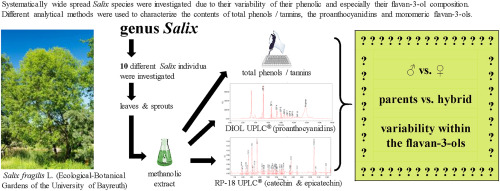当前位置:
X-MOL 学术
›
Phytochemistry
›
论文详情
Our official English website, www.x-mol.net, welcomes your feedback! (Note: you will need to create a separate account there.)
Investigation of the flavan-3-ol patterns in willow species during one growing-season
Phytochemistry ( IF 3.8 ) Pub Date : 2018-01-01 , DOI: 10.1016/j.phytochem.2017.10.001 Stefan Wiesneth , Gregor Aas , Jörg Heilmann , Guido Jürgenliemk
Phytochemistry ( IF 3.8 ) Pub Date : 2018-01-01 , DOI: 10.1016/j.phytochem.2017.10.001 Stefan Wiesneth , Gregor Aas , Jörg Heilmann , Guido Jürgenliemk

|
Flavonoids, proanthocyanidins (PAs) and salicylic alcohol derivatives are the main groups of ingredients in Salix needed as defensive tools and signal molecules, but have also pharmaceutical importance. The present study investigated total PA content, complete PA pattern, the oligomeric/total PAs quotient and the contents of catechin and epicatechin during one growing-season for the leaves and this year's sprouts in ten willows (Salix pentandra L. ♂, S. alba L. ♂, S. fragilis L. ♀, S. caprea L. ♂ & ♀, S. cinerea L. ♂, S. caprea x cinerea ♂, S. daphnoidesVill. ♂ & ♀ and S. purpurea L. ♀; all Salicaceae). Comparison of the different species revealed distinct seasonal fluctuations of the oligomeric and polymeric PA fractions, but the contents of both groups always developed in the same direction. All willows prefer the synthesis of PAs with DP-2 - DP-4 within the oligomeric fraction (DP-2 - DP-10) and species with rather low PA contents like S. purpurea (0.1-2.6 mg/g) as well as species with rather high PA contents like S. alba (3.8-14.7 mg/g) were found. Only slight gender specific differences could be observed for both sexes of S. daphnoides and S. caprea. The PA pattern of the hybrid S. caprea x cinerea seems to be influenced by both parents. Thus, the accumulation of the oligomeric PAs accorded to S. caprea and the polymeric PAs matched S. cinerea resulting in an overall depression of PAs in the sprouts and a varying seasonal trend in the leaves. In contrast, the content of catechin remained high and seemed to be not influenced in the hybrid. Although only one individual of each Salix species could be considered in this screening study, the present results demonstrate the variability of the flavan-3-ol pattern within the genus Salix but also some preliminary correlations could be observed. Future studies with more Salix species will provide more insights into chemotaxonomic correlations.
中文翻译:

一个生长季柳树种黄烷-3-醇模式的调查
黄酮类化合物、原花青素 (PA) 和水杨醇衍生物是 Salix 中作为防御工具和信号分子所需的主要成分,但也具有药学重要性。本研究调查了 10 棵柳树 (Salix pentandra L. ♂, S. alba) 在一个生长季节的叶子和今年新芽的总 PA 含量、完整 PA 模式、低聚/总 PA 商以及儿茶素和表儿茶素的含量L. ♂、S. fragilis L. ♀、S. caprea L. ♂ & ♀、S. cinerea L. ♂、S. caprea x cinerea ♂、S. daphnoidesVill. ♂ & ♀ 和 S. purpurea L. ♀;所有杨柳科)。不同物种的比较揭示了低聚和聚合 PA 组分的明显季节性波动,但两组的含量总是朝着相同的方向发展。所有柳树都喜欢在低聚部分 (DP-2 - DP-10) 内合成具有 DP-2 - DP-4 的 PA 和具有相当低 PA 含量的物种,如 S. purpurea (0.1-2.6 mg/g) 以及发现了具有相当高 PA 含量的物种,如 S. alba (3.8-14.7 mg/g)。对于 S. daphnoides 和 S. caprea 的两性,只能观察到轻微的性别差异。杂种 S. caprea x cinerea 的 PA 模式似乎受到父母双方的影响。因此,寡聚 PAs 的积累符合 S. caprea 和聚合 PAs 匹配 S. cinerea 导致芽中 PAs 的整体抑制和叶子中不同的季节性趋势。相比之下,儿茶素的含量仍然很高,似乎在杂种中没有受到影响。虽然在这项筛选研究中只能考虑每个柳属物种的一个个体,但目前的结果证明了柳属内黄烷-3-醇模式的可变性,但也可以观察到一些初步的相关性。未来对更多柳属物种的研究将为化学分类学相关性提供更多见解。
更新日期:2018-01-01
中文翻译:

一个生长季柳树种黄烷-3-醇模式的调查
黄酮类化合物、原花青素 (PA) 和水杨醇衍生物是 Salix 中作为防御工具和信号分子所需的主要成分,但也具有药学重要性。本研究调查了 10 棵柳树 (Salix pentandra L. ♂, S. alba) 在一个生长季节的叶子和今年新芽的总 PA 含量、完整 PA 模式、低聚/总 PA 商以及儿茶素和表儿茶素的含量L. ♂、S. fragilis L. ♀、S. caprea L. ♂ & ♀、S. cinerea L. ♂、S. caprea x cinerea ♂、S. daphnoidesVill. ♂ & ♀ 和 S. purpurea L. ♀;所有杨柳科)。不同物种的比较揭示了低聚和聚合 PA 组分的明显季节性波动,但两组的含量总是朝着相同的方向发展。所有柳树都喜欢在低聚部分 (DP-2 - DP-10) 内合成具有 DP-2 - DP-4 的 PA 和具有相当低 PA 含量的物种,如 S. purpurea (0.1-2.6 mg/g) 以及发现了具有相当高 PA 含量的物种,如 S. alba (3.8-14.7 mg/g)。对于 S. daphnoides 和 S. caprea 的两性,只能观察到轻微的性别差异。杂种 S. caprea x cinerea 的 PA 模式似乎受到父母双方的影响。因此,寡聚 PAs 的积累符合 S. caprea 和聚合 PAs 匹配 S. cinerea 导致芽中 PAs 的整体抑制和叶子中不同的季节性趋势。相比之下,儿茶素的含量仍然很高,似乎在杂种中没有受到影响。虽然在这项筛选研究中只能考虑每个柳属物种的一个个体,但目前的结果证明了柳属内黄烷-3-醇模式的可变性,但也可以观察到一些初步的相关性。未来对更多柳属物种的研究将为化学分类学相关性提供更多见解。



























 京公网安备 11010802027423号
京公网安备 11010802027423号